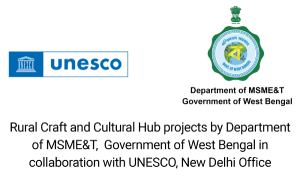Background
The partnership between UNESCO and the Government of West Bengal started in 2013. It is a long-standing partnership which has over the years grown in stature due to the positive impacts of the project. The success of this co-operation is strongly rooted in the methodology, conception and execution of project. It has brought to the forefront, the economic viability and potential for sustainable development emerging from ICH and traditional art forms from the most rural and remote areas of West Bengal, India.
Each district of West Bengal has its own unique performing art and handicrafts. Understanding the importance of developing ICH based entrepreneurship, sustaining the art forms, strengthening the socio economic condition of the artisans and creating cultural tourism destination hubs the Department of Micro, Small and Medium Enterprises and Textiles (MSME&T) associated with UNESCO in 2013 to develop Rural Craft Hubs covering 10 craft forms and 3000 artists. The success led to partnership for developing Rural Craft and Cultural Hubs from 2016 – 2019, which covered 12000 artists beneficiaries across 15 art and craft forms. The success of these initiatives led to the present phase of the project covering 50000 artist beneficiaries. The partnership has supported the intergenerational transmission of Intangible Cultural Heritage (ICH) and arts in the culturally rich Indian State of West Bengal over several years and remains strongly aligned with the 2030 Agenda for Sustainable Development. The project and its phases have been fully endorsed by the Government of West Bengal. Almost a decade since they initially began, the projects remain ground-breaking.
The previous projects have led to safeguarding of more than 10 artforms. The crafts persons which were largely wage based artisans, having lack of design, access to technology, deficient market linkages, lack of training are now an energised community and all of the challenges were addressed. The income of the craft artists have enhanced from Rs 3000/- on an average to Rs 8000/- on an average. The performing artists who hardly were getting paid from their performances have now not only performing at district and state level, but also travelling internationally. Average age of the artists has gone down substantially, and migration have reduced. Institutions have strengthened and micro entrepreneurship helped in enhancing production and profitability. The Government worked towards developing 14 folk art centres and community museums at the hubs which embody the way of life and cultural heritage of the community. Annual fairs in the villages celebrating their heritage strengthened recognition of the artists and the village. Regular tourists started to flow in which was almost nil and direct sales from the village got established. Local administration came forward in strengthening the infrastructure in the villages. Slowly, the villages emerged as cultural tourism destinations, drawing crowds in thousands from the neighbouring towns and villages and also national and international visitors. Direct recipients who have benefitted in the process have been the artists, their art and the villages they dwell in. Six unique crafts from this rich repository, namely Patachitra, Dokra, Chau Mask, Wooden mask, Madur and Terracotta have also been accredited with the Geographical Indication status.
Objectives
Goal is to develop eco-system to incubate creative entrepreneurship at Rural Craft and Cultural Hubs for holistic growth of arts, artists and villages in West Bengal and foster socio-economic empowerment of 50000 artists and crafts persons by developing ICH based livelihood and enterprises.
The overall objective for the project is to build sustainable communities, protect and safeguard cultural heritage, enhance wellbeing, address income inequalities, promote economic empowerment of marginalised groups, and reduce poverty through the safeguarding of occupational forms of performing arts and crafts in West Bengal.
Coverage
RCCH covers 50000 Intangible Cultural Heritage (ICH) practitioners pursuing 35 traditional craft and performing arts in 20 districts in West Bengal. 79% of the artists belong to marginalised groups under Other Backward Classes (OBC), Scheduled Castes (SC) and Scheduled Tribes (ST). Indigenous communities in Cooch Behar, Alipurduar, Darjeeling, Uttar and Dakshin Dinajpur, Purulia and Bankura are covered under the project. 58% of the artists are women.
The following list shows the names of art and craft forms -
Handicraft
- Sholapith at Purba Bardhaman, Alipurduar, Birbhum, Dakshin Dinajpur, South 24 Parganas, Uttar Dinajpur
- Bamboo works at Uttar Dinajpur, Dakshin Dinajpur, Malda, Purba Bardhaman, Paschim Bardhaman, Birbhum, Purulia, Darjeeling, Jalpaiguri and Kalimpong
- Pottery at Uttar Dinajpur, North 24 Parganas and Birbhum
- Dhokra at Uttar Dinajpur and Dakshin Dinajpur
- Patachitra at Purba Medinipur, Paschim Medinipur, Birbhum, Bankura and Purulia
- Chau Mask at Purulia
- Clay Doll at Nadia
- Dokra at Purba Bardhaman and Bankura
- Folk Instrument at Bankura, Nadia and Purulia
- Wood Craft at Kalimpong
- Kantha Embroidery at Birbhum and Purba Bardhaman
- Handloom of Kenjakura, Bankura
- Madur of Purba and Paschim Medinipur
- Rabha weaving of Alipurduar, Coochbehar, Jalpaiguri
- Sabai of Bankura, Purulia and Jhargram
- Sitalpati of Coochbehar
- Terracotta of Bankura
- Wooden Doll of Purba Bardhaman
- Wooden Mask of Uttar and Dakshin Dinajpur
Performing Art
- Baul & Fakiri at Purba and Paschim Bardhaman, Murshidabad, Nadia, Birbhum and Bankura.
- Bhawaiya at Alipurduar, Jalpaiguri and Cooch Behar.
- Bhatiyali at North 24 Parganas.
- Jhumur at Purulia, Bankura and South 24 Parganas.
- Chau at Purulia.
- Raibenshe at Murshidabad, Birbhum and Purba Bardhaman.
- Mukha dance at Dakshin Dinajpur and Uttar Dinajpur.
- Darjeeling folk songs and dance forms at Darjeeling and Kalimpong.
- Banbibir Pala at North 24 Parganas and South 24 Parganas.
- Khon at Dakshin Dinajpur and Uttar Dinajpur.
- Domni at Malda.
- Gambhira at Malda
- Puppetry at Nadia and Bankura.
- Chador Bador at Purba Bardhaman
- Rabha dance and music at Alipurduar and Jalpaiguri
- Tribal song and dance at Jhargram and Paschim Bardhaman
Get details of artists : https://artists.banglanatak.
Capacity building
Skilling performing artists : Workshops addressed skilling through Guru Shishya Parampara (master disciple skill transmission), revival of lost traditions, developing new productions, and presentation skills. Training of trainers approach was used and master artists trained new beneficiaries inducted into the program. Theatre, music and dance specialists worked with the traditional masters for developing the curriculum.
Capacity building of crafts persons : Designers and craft specialists guided and monitored the programs for the craft products. Product innovation and service development workshops contributed to adding the market informed range of innovative products by maintaining the heritage skill sets of the cluster. A monthly training plan was drawn up for building knowledge of master crafts persons in contemporary design and market for augmenting their competitiveness. Training was also held with the artists to scale up leading groups and makers and provide entrepreneurship training to the leaders. Business, communication, digital skills training was taken up with the artists.
Capacity building workshops covered 14862 artists (4238 handicraft artists and 10624 performing artists) out of 14700 targeted for Year 1 (Basic training of 12750 artists and advanced training for 1950 artists)
Promotion
Fairs and exhibitions provide good opportunities for promoting the traditional arts and crafts in the market and get the market feedback for further improvement. The artists get exposure to a wider market by participating in these fairs and exhibitions. Rural artists and crafts persons are visiting all over India including Delhi, Kolkata, Bengaluru, Chennai, Rajasthan. The artists are constantly linked to various faris and exhibitions. The craft artists are linked to various e-commerce platforms. Social media pages are constantly updated. 300 artists have participated in the festivals. Village festival has been held at Malda where local crafts and folk theatre forms like Gambhira and Domni has been showcased.
The first year of the project had 286 days of reach out, covering 48 events, wherein 534 artists participated.
69 persons (45 men, 24women) also participated in international festivals across Portugal, UK, Denmark, Singapore, Indonesia, Czech Republic, Sweden, Kyrgyzstan and Bangladesh.It was first opportunity for international travel for 21 artists. Participating at the international festivals for the first time opened up new perspective for the artists and aspiration for others in the community.
Infrastructure
As part of Rural Craft Hub and Rural Craft and Cultural Hub initiative folk art centers have been developed at various hubs.
Infrastructures developed as part of RCH project (2013-2016): Sitalpati centre at Ghughumari, Coochbehar, Wooden Mask centre at Kushmandi, Dakshin Dinajpur, Chau Mask centre at Charida, Purulia, Terracotta centre at Panchmura, Bankura, Wooden Doll centre at Natungram, Purba Bardhaman, Dokra centre at Bikna, Bankura and Dariyapur, Purba Bardhaman, Patachitra centre at Naya, Pingla, Paschim Medinipur.
Infrastructures developed as part of RCCH Project (2016-2019) : Chau centre at Maldi, Purulia, Baul centre at Jalangi and Hariharpara, Murshidabad, Sunderban folk art centre at Pakhiralay, South 24 Parganas.
Infrastructures developed by WBKVIB under its various projects (2016-2019) : Sal and Sabai Centre of Excellence at Jhargram, Madur centre at Sarta. 8 Madur production units at Sabang and Pingla.
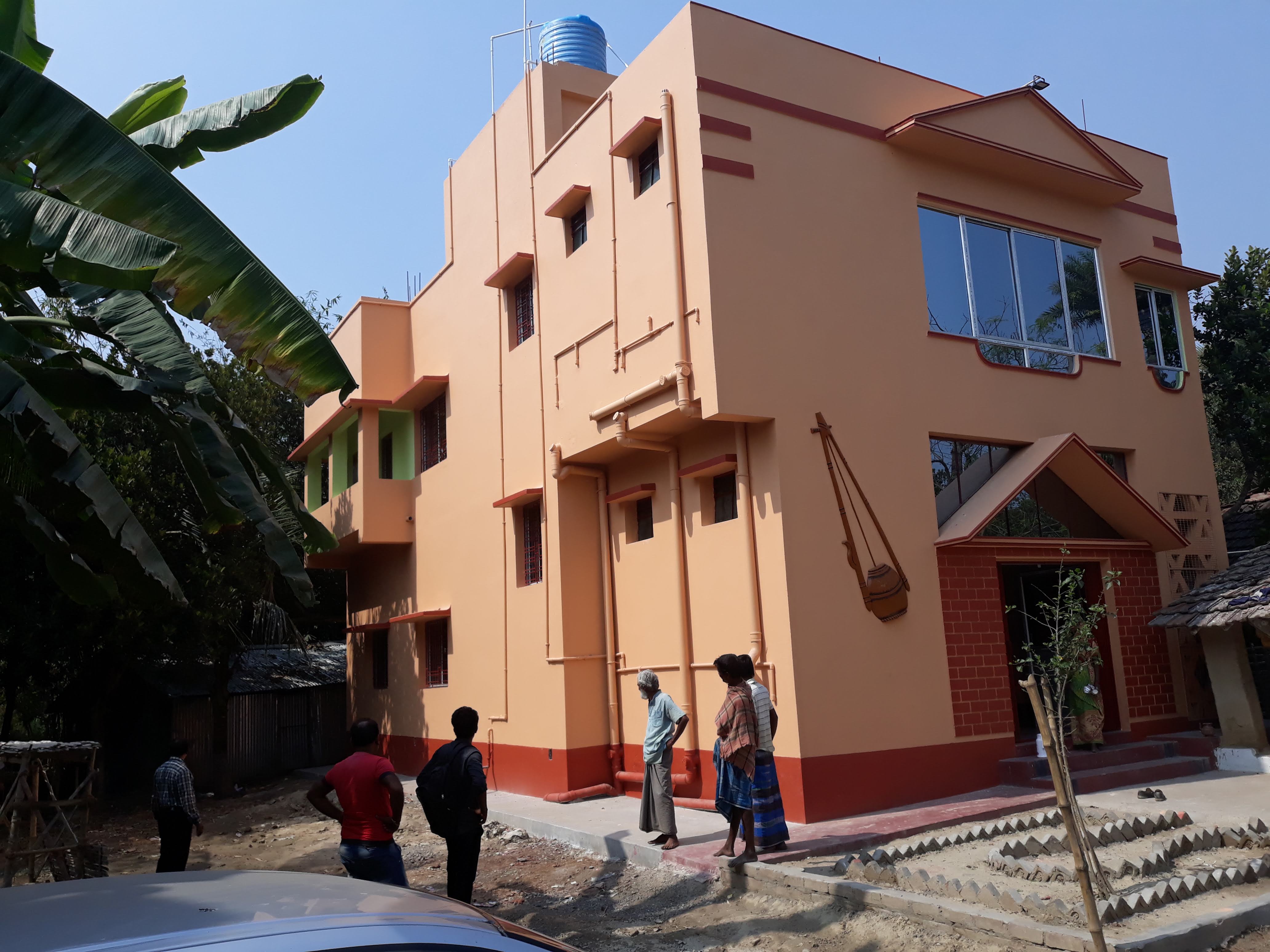
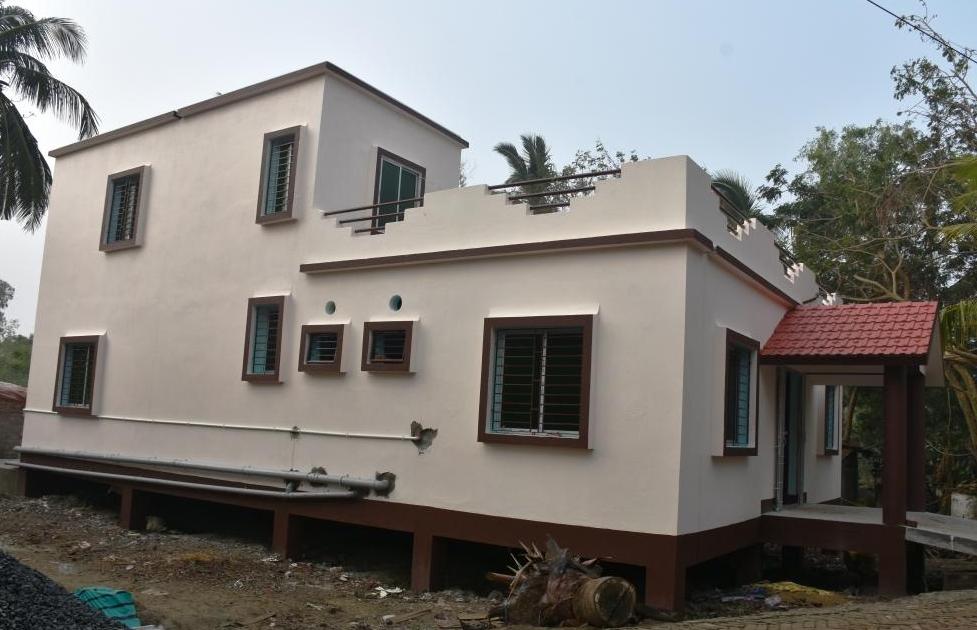
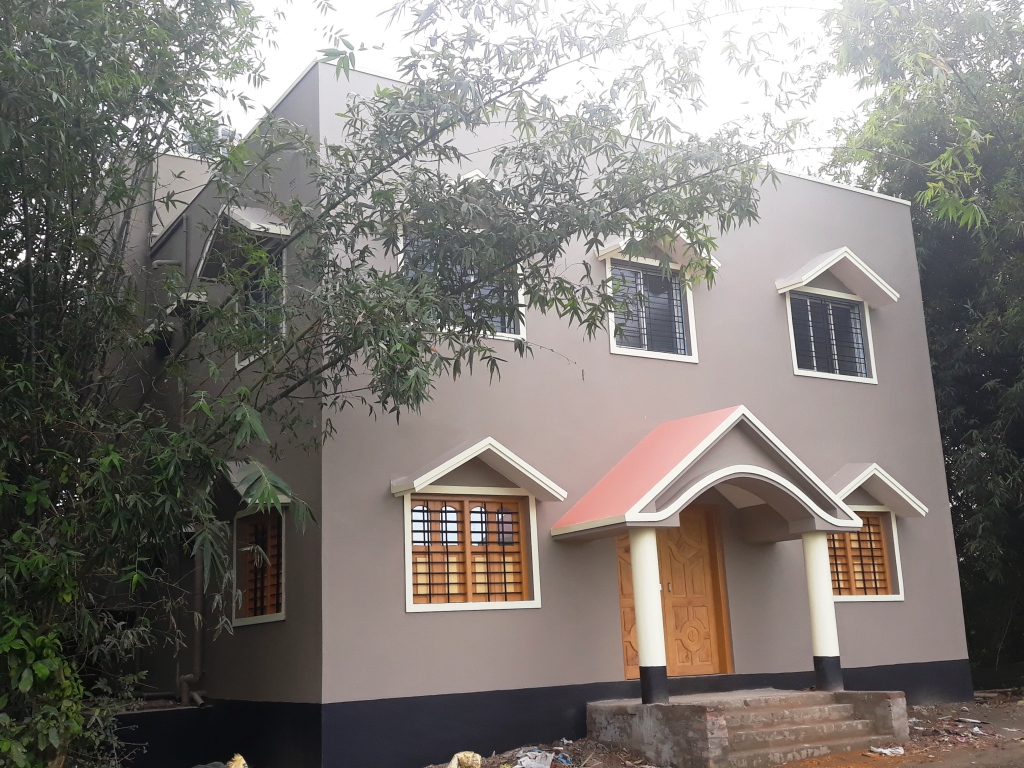
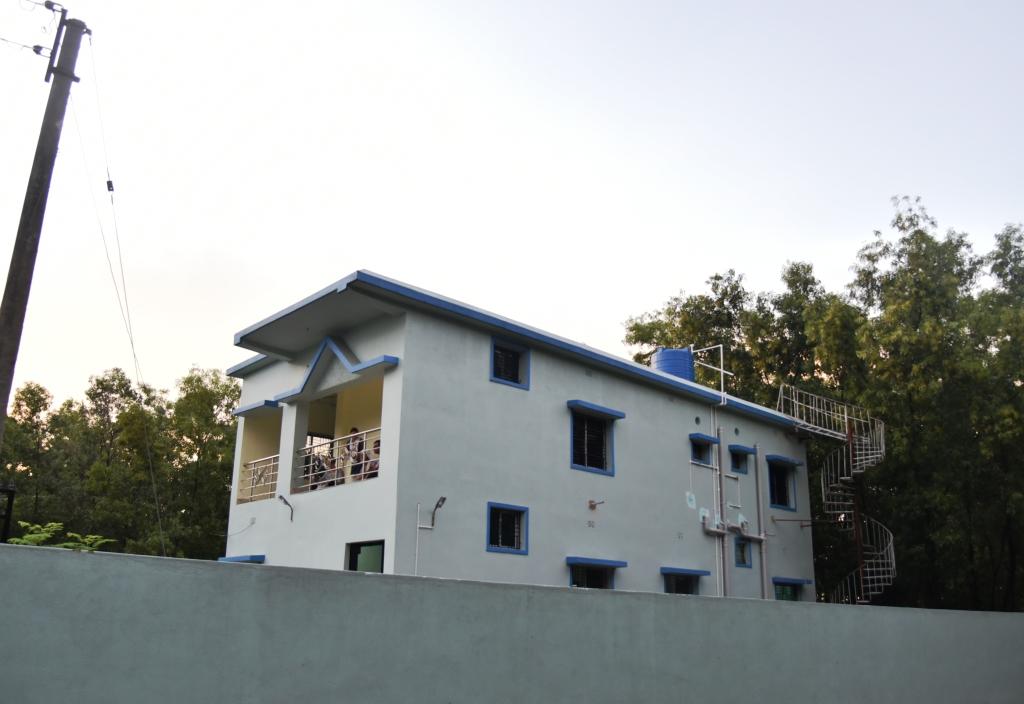
Documentation
Documentation of ICH is regarded as one of the most important component of the UNESCO Convention of 2003 to Safeguard ICH. The convention emphasizes on documentation of oral traditions and expressions, performing arts, social practices, rituals and festive events, knowledge and practices concerning nature and universe and traditional craftsmanship.
Documentation as part of the RCCH II Project
AV Dcomentary:
Chau Documentary : https://www.youtube.com/watch?v=90J_TtpSAMI&t=1s
Bhawaiya : https://youtu.be/NAv0vF3b-ms?si=VipfuGV51Q7_0kPP
Chadar Badar : https://youtu.be/Rru8H54GjIw
Kantha : https://youtu.be/X40L8-NcJbQ
Sabai : https://youtu.be/mOepCaSw3iI
Baul-The search within -https://youtu.be/RrvLpxZayWM?si=52nRNE6k9kZ_rMIU
Music Albums;
Jhumur : https://www.youtube.com/playlist?list=PLnJ4jEhTwdDQqfPqXD8-GVak7gXDYTTW2
Baul : https://youtu.be/befyyA14kzQ?si=beW1PLbsydA2ECAg
Bhawaiya : https://youtu.be/vDDCuU_hg-M?si=rYu1rpDPHJXcq-cr
https://youtu.be/fZfJxYILqw0?si=WqBTsyv9t5adXbe1
Cultural tourism
 Many of the art and craft villages has evolved as cultural tourism destinations. Visitors travel to these destinations regularly. Some of the prominent hubs are Naya in Paschim Medinipur known for patachitra painting, chau mask village of Charida, Dokra village of Bikna, Bankura, Terracotta village of Panchmura, Sarta, Madur village of Sabang, Paschim Medinipur, Kantha village of Nanoor. Some of the music villages like Gorbhanga of Nadia, Salkumar of Alipurduar are also slowly evolving as cultural tourism destinations.
Many of the art and craft villages has evolved as cultural tourism destinations. Visitors travel to these destinations regularly. Some of the prominent hubs are Naya in Paschim Medinipur known for patachitra painting, chau mask village of Charida, Dokra village of Bikna, Bankura, Terracotta village of Panchmura, Sarta, Madur village of Sabang, Paschim Medinipur, Kantha village of Nanoor. Some of the music villages like Gorbhanga of Nadia, Salkumar of Alipurduar are also slowly evolving as cultural tourism destinations.
Village festivals are integral part to promote these cultural tourism destinations. 15 festivals celebrating ICH were held. Five festivals have been held at the district headquarters, in Malda, Birbhum, Kalimpong, Jalpaiguri,and Uttar Dinajpur. Seven were held at villages in Dariyapur (Dokra), Bikna (Dokra), Pakhiralay (Sunderban ICH traditions), Natungram (Wooden Doll), Gorbhanga (Baul Fakiri), Bamnia (Chau and Jhumur), and Charida (Chau mask). The festivals were held under the brand KaruKalaUtsav in close coordination with the district task force and the artists. 2420 artists participated in the village festivals with participation of 999 handicrafts,1421 performing artists.
